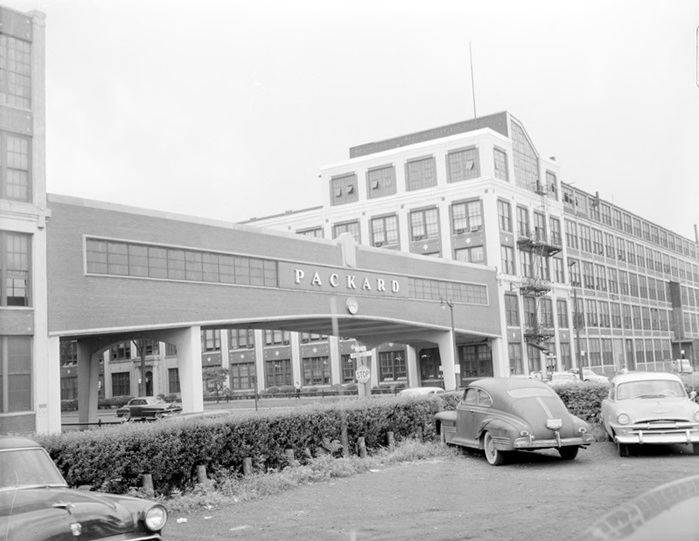Type Automobile factory Completed 1911 Floor area 33 ha Construction started 1903 | Opened 1911 Structural engineer Henry Bourne Joy | |
 | ||
Status Undergoing cleanup, renovations and reconstruction Similar Michigan Central Station, Fisher Building, Heidelberg Project, Belle Isle Park, Ford River Rouge Complex | ||
The Packard Automotive Plant is a former automobile-manufacturing factory in Detroit, Michigan where luxury cars were made by the Packard Motor Car Company and later by the Studebaker-Packard Corporation.
Contents
- Map of Packard Automotive Plant Detroit MI 48211 USA
- Design and operation
- Current status
- Sale
- References
Map of Packard Automotive Plant, Detroit, MI 48211, USA
Design and operation
The 3,500,000-square-foot (325,000 m2), plant was designed by Albert Kahn Associates using Trussed Concrete Steel Company products. It is located on 40 acres (16 ha) of land on East Grand Boulevard on the city's east side. It included the first use of reinforced concrete in the United States for industrial construction in the automobile industry.
The Packard plant was opened in 1903 and at the time was considered the most modern automobile manufacturing facility in the world with skilled craftsmen involved in over eighty trades. The factory complex closed in 1958, though other businesses operated on the premises or used it for storage until the late 1990s.
A number of the outer buildings were in use by businesses up through the early 2000s. In 2010, the last remaining tenant, Chemical Processing, announced its intention to vacate the premises after 52 years.
Current status
Since its abandonment, the plant has been a haven for graffiti artists, urban explorers, paintballers and auto scrappers, and much of the wiring and other building material has been scavenged. In one incident, vandals pushed a dump truck from the fourth floor. Karen Nagher, the executive director of the nonprofit organization Preservation Wayne, stated that she was irked to see people come from "all over the world" to poke around Detroit. "Piece by piece, they're disassembling those buildings, making it harder and harder to restore them".
Despite many years of neglect and abuse, the reinforced concrete structures remain mostly intact and structurally sound. Portions of the upper floors of several small sections in various buildings have collapsed or been partly demolished and lay in ruins in the wake of several aborted attempts at demolition over the years.
The City of Detroit has pledged legal action to have the property demolished or secured. Dominic Cristini, whose claim of ownership is disputed, was said to be conducting construction surveys in advance of full-scale demolition as of early 2012.
On February 5, 2013 it was reported that aluminum letter placards spelling the Nazi Slogan "Arbeit macht frei" (work makes free) were placed in the windows of the E. Grand Boulevard bridge. Community volunteers promptly removed the letters.
In April 2013, it was announced that AMC's Low Winter Sun would be filming around the location.
Sale
Due to tax delinquency, the 43 parcels composing the plant were put up for auction in September 2013. The starting bid was $975,000 (the amount owed in taxes) and there were no takers.
Another auction in October 2013 posted a starting bid of $21,000, or about $500 per parcel. This auction closed with a top bid of $6,038,000 by Dr. Jill Van Horn, a Texas-based physician who announced in an email that she would team up with “partners and investors from Detroit, Wall Street and international firms,” to turn the site into an “economic engine”, refurbishing the plant grounds for a manufactured-house assembly facility. However, the deadline for full payment was missed, prompting Wayne County to initiate talks with the second-highest bidder, Bill Hults, a Chicago-area developer who placed a $2,003,000 bid in the October auction. In a separate email, Dr. Van Horn stated, "It seemed (David Szymanski, Deputy Wayne County Treasurer) had already made up his mind to talk to the second bidder". Hults then made several non-refundable down-payments on the plant, but he ultimately failed to raise the entire sum of his bid.
Around the same time in October 2013, a Spanish investor, Fernando Palazuelo, also expressed interest in securing the Packard Plant. It was purchased for $405,000 on December 12, 2013. Palazuelo plans on moving into the plant by April 9, his 59th birthday. He plans on having six different uses for the Packard Plant Project (residential, retail, offices, light industry, recreation and art) that is estimated to cost about $350 million over the next 10 to 15 years. First, he hopes to bring a big 3 automotive parts manufacturer to the plant in exchange for a few years of free rent. He also hopes to create a work space for local artists and an upscale go-kart track.
As of August 2016 no redevelopment has actually taken place at the historic 40-acre site on Detroit’s east side. And many remain skeptical that the enormous effort will ever succeed — or even get off the ground — given the nearly half-billion-dollar price tag of the project that Palazuelo has envisioned.
